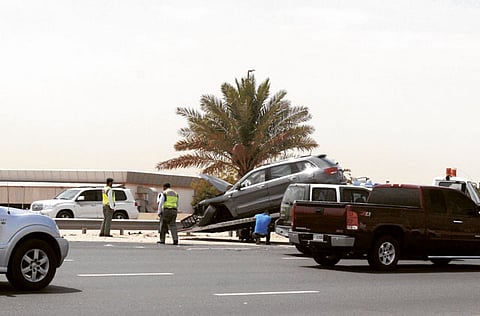Sudden swerving main cause of road deaths in Dubai
76 people were killed and 884 others injured in 1,250 major traffic accidents this year, say Dubai Police

Dubai: Sudden swerving resulted in the most fatalities on Dubai roads this year; it has resulted in 23 deaths so far; a Dubai Police official said on Saturday.
Statistics by Dubai Police show that during the first half of this year, 76 people were killed and 884 others injured in 1,250 major traffic accidents as compared with the same number of deaths and 996 others injured in 1,447 major traffic accidents in the same period in 2017.
Brigadier Saif Muhair Al Mazroui, director of Traffic Department in Dubai Police, said that main reason behind death was sudden swerving despite many awareness campaigns to warn drivers about its dangers.
"Sudden swerving caused 317 serious traffic accidents [and] resulted [in] 23 deaths and 268 injuries. It is a danger[ous] offence despite [the fact] motorists think it is not that danger[ous]," Brigadier Al Mazroui added.
Non-compliance with the compulsory lane for light vehicles caused the second-most number of deaths in Dubai this year; it resulted in 17 deaths in 132 serious traffic accidents. Meanwhile, failure to leave safe distance between vehicles caused 235 serious traffic accidents and resulted in 15 deaths and 179 injuries.
Brigadier Al Mazroui, pointed out that Emirates road was most dangerous road in Dubai, as it witnessed 30 serious traffic accidents where 14 people were killed. Shaikh Mohammad Bin Zayed road had 72 serious accidents, which resulted in eight killed, and Shaikh Zayed Road saw eight people die in 69 serious traffic accidents.
However, several initiatives, new rules and traffic awareness campaigns have been conducted by Dubai Police and the Ministry of Interior to reduce road fatalities. Among them is reducing the speed limit to 110km/h on two major roads in Dubai, Shaikh Mohammad bin Zayed and Emirates roads.
After studies, both highways were found to be carrying large volumes of traffic and were hot spots for accidents and collisions. The move came into force from October 15, 2017.
Sign up for the Daily Briefing
Get the latest news and updates straight to your inbox


